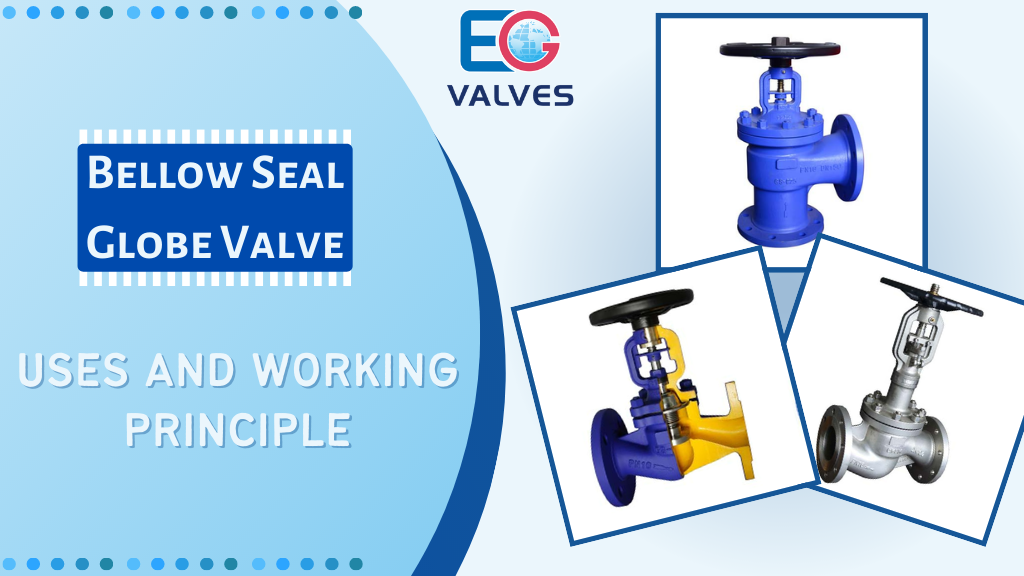Industrial valves are simple devices that are multi-functional and developed to manage the flow of fluid by regulating the passageway or pipes. Commonly used in the domestic plumbing system, faucets, and commercial buildings, valves have the basic function to let the water come out and turning it back to water stops flowing. When it comes to the types of ball valves that exist in the market, there are certain categories such as ball valve, gate, pinch, butterfly, diaphragm, and globe valves. In comparison to the other types, globe valves offer greater precision for the purpose of regulating flow. Bellow Seal Globe Valve, being spherical in shape, is named so and is preferably used in applications where fluid flow needs to be finely tuned.
Just like the gate valves, the globe valve follows a linear pathway to throttle flow. However, both types vary in terms of using a disk in the place of a wedge. The merit of using globe valves over others is that they can be easily adjusted to higher or lower flow and it does not leak as the other types of valves. Due to their specific design and structure, these valves are known to provide excellent control to normalize the fluid flow. Usually, water pipes are fitted with these kinds of valves. So that the operator can control the regulation inside the pipe by opening the valve partly or completely opening it. This is the reason the globe valve is believed to be the most popular valve to be used for different applications.
Sealability as a Vital parameter for a Globe valve:
One of the most basic and crucial features of all kinds of valves is sealability, which can be detached into the external and internal seal. The exterior sealing reveals the sealing between the moving parts of the valve stem and bonnet, body, and connection, and also to the valve body and bonnet. On the contrary, the internal seal indicates the connection between the seat and the valve clack.
The inadequate sealability and lack of strength may damage the parts of the valve. It may lead to monetary loss at different levels, including in transportation, explosive and corrosive fluid. Or it might lead to a serious accident as well. What ensures the sealing of the valve is following the standards to design that should be according to the material of the product.
Defining Bellow seal globe valve?
There is no such big difference between a control valve and a bellow seal valve structural design. What distinguishes the later one is the use of bellows to seal the components of the valve stem. There are several characteristics of bellow values that are helpful in passing even the hazardous and explosive media.
The typical utilization of the bellow seal valve is like the obstruction between air and fluids. At the same time, the unit ensures fluid leakage with zero leakage of pipelines.
Now, what can be done to avoid processing fluids affecting the valve stem? The bellows of the bottom are welded to the stem while the flip side of the bellows creates a static seal between the bonnet and the body of the valve.
Different industries today are in great need of Bellow Seal Globe Valves for their applications. Such industries include modern nuclear, petrochemical, automation control, electric and space, long-distance fluid transportation, and others. To ensure good sealability and desired strength, valve manufacturers are focusing on expanding other parameters of the valve so as to develop automatic, energy-saving, and multi-functional valves.
Bellow materials
In usual conditions, the bellow seal globe valve is made up of cast iron or cast copper. It proves beneficial for low-pressure and non-corrosive fluid. Whereas, for the high or medium pressure fluid, the valve is made up of cast steel or forged steel.
Using alloy steel is preferred for high-temperature or high-pressure fluids. In addition to these materials, plastics, stainless steel, lead alloy, and titanium alloy are preferred materials for regulating corrosive fluid. In particular, such valves ensure high and efficient functionality in the above-level temperature and pressure applications.
When it comes to distinguishing materials, the ones that have gained huge attention in the industry are stainless steel with Titanium to survive high pressures and temperatures. Inconel 600 or 625 enhances fatigue strength and makes it resistant-free as opposed to the stainless steel bellows.
What’s more, Hastelloy C-276 ensures works better in terms of avoiding corrosion and fatigue. The only solution here is to make use of different bellow systems for the purpose to minimize the stroke length and improving the utility life.
In order to perfectly manage above-level pressure fluids, the beneficial thing is to use a multi-ply design. Such utilization leads to a two-ply bellow which can directly impact the pressure rating in contrast to using a single ply bellow with a similar thickness level. The reason is clear; there are more benefits of utilizing multi-systems over a single-ply system.
Metal fatigue is common bellow that can induce weld failure. Now there are some usual aspects that impact the fatigue life and such include the technique to fabricate, length of the stroke, frequency of the stroke, fatigue life, and others.
Types of bellow
Typically, there are two kinds of the bellow. The one that is more commonly used in industrial applications is the Forged Bellow while another less common is the Welded. Their construction is simple, just by converting a flat sheet into a tube that is fusion welded. The tube formation in this regard is turned into bellow that is circular in shape and possesses folds. In moving toward understanding the welded type, it is significant to know that their creation is done by welding process with thin plates and the specified inner/outer circumference of the plates.
Common features of Bellow Seal Globe Valves:
Reduced gland leakage
From the gland parts, the adequate utilization of bellows minimizes the leakage risk.
Ideal for energy savings
The loss of energy no to little leakage is controlled. This aspect leads to protecting the environment.
Prevents minor leakage
The use of bellows guarantees leakage, which makes them ideal to prevent minor leakage from gland components. In addition, bellow seal globe valves suit safety aspects for toxic liquids, flammable liquids, and also for liquids with odors.
Easy to maintain
Reduces maintenance expense as the bellow seal globe valves do not require to be regularly retorqued.
Ensures liquid quality
Both the stem and the gland components are sealed with bellows to avoid contact with liquids in pipes.
Durability
The bellow seal globe valve ensures good durability as these are built from a single metal. The most attractive characteristic is the reliability that is enough good for forged types. While it is low for welded ones because of the small-sized spots that affect their life cycle.
Quality control
For the forged ones specifically, it is easy to test quality as they are formed uniformly. However, in the welded bellows, it becomes difficult to inspect the welded spots for quality purposes.
The basic structure of bellow seal globe valve
The structure is simple and standard that has a rotation-less stem and handles to avoid bellows twisting.
The structure further has gland packing that helps prevent external leakage. Its structural design for the bolt is convenient to maintain and manage with the bolt being tightened and that ensures quick and safe fastening. The hydraulic multi-layer bellows are used that feature excellent features and corrosion resistance.
For the upper gasket, the expanded graphite seat is used to restrict the external leakage in the event of bellows breakage.
Regular Globe valves vs Bellow seal globe valves
Now what distinguishes the bellow seal globe valves from the standard globe valve is the sealing performance. This aspect makes the bellow ones more efficient to provide the security of pipelines.
This is the regular type which is seal packed and works best to avoid forming tight contact with the stem of the valve. This usually causes high leakage specifically under low temperatures.
When it comes to usage, the difference is huge again. Generally, the bellow ones are used for pipelines with permeable media like ammonia. However, the regular ones are used for standard purposes where sealing performance is not a big concern.
These are spherical in design and provide greater accuracy than different sorts of valves when it comes to regulating flow. As per the Globe Valve Manufacturer, these types are mainly used for purposes the place liquid desires to be finely tuned. Due to their precise format and structure, these valves are acknowledged to furnish extraordinary manipulation to normalize the fluid flow. Usually, water pipes are outfitted with these types of valves so that the operator can manipulate the interior of the pipe with the aid of opening the valve partly or definitely opening it. The functioning here makes it efficient for the industries to avoid volatile leaks.
In addition, the industries cannot expect any loss in media due to the usage, however in the regular kinds; they may have to face such circumstances. The only reason for good bellow valve life in comparison to the others.
Working principle for Bellow Seal Globe Valve
During the installation times, different positions can be made in possible ways. Following this way will save the debris accumulation in the bellow. While the process is under, it is required to ensure that the pipes installed do not contain any kind of impurity. Such a connection can be created so as to circumvent tension that acts on the valve.
Not like the other kinds of valves, a unique methodology is followed in the below case. Here, a metal tube connected to the bonnet and valve stem is used to create a leak-proof seal with no friction or resistance.
The utilization of the accordion ribs makes the bellows stretch and compress with a stem’s linear motion. Being the uninterrupted metal tube, bellows leave no chance for leakage.
The port on the extended bonnet serves as the connection point to inspect fluid leakage. Also, in some applications, the On and Off system is used to take immediate action on detection.
The detection sensor used in the system can be as modest as can be calibrated at some pressure level. On breaking the bellow seal breakage, the detector sensor may indicate the leak with the packing to ensure quality working until repairing work gets completed.




